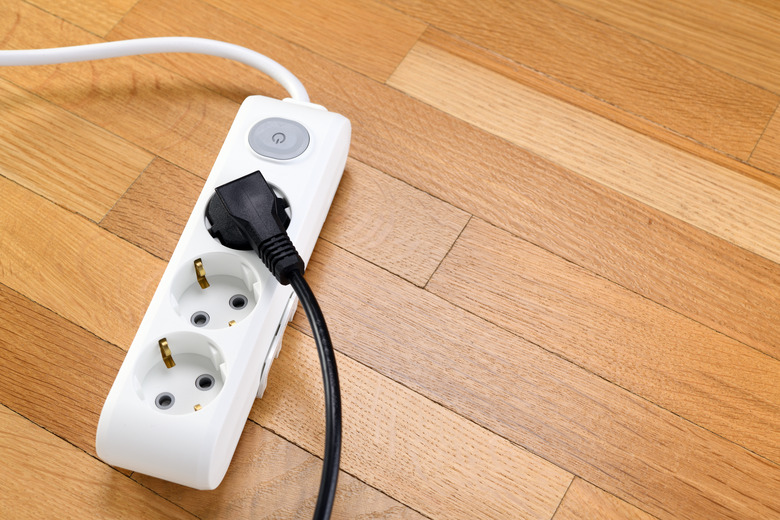OSHA Rules On Extension Cord Safety
We may receive a commission on purchases made from links.
The rules set forth by the Occupational Health and Safety Administration (OSHA) are, of course, intended to keep employees safe at work, but following them can also help keep you safe at home. OSHA has very strict standards for when and how to use extension cords, and they really apply to everyone whether at work or at home. An OSHA inspector certainly won't come knocking on your door asking about an extension cord in your bedroom, but you'll be safer if you follow OSHA guidelines anyway.
Extension Cord Time Limits
Extension Cord Time Limits
Extension cords are quite handy when you need to plug in something and you can't conveniently reach an outlet. However, they aren't intended to be a permanent solution. OSHA standards allow the use of an extension cord for a maximum of 90 days. If you need the cord longer than that, you're required to create a more permanent solution and hardwire whatever you're plugging in.
The same is true at home. If you're plugging in a television, game system, lamp, microwave, or other appliance that you intend to use long term, an extension cord isn't the answer. You may need to use an outlet strip with surge protection or have an electrician add an outlet to your home. Don't plan on an extension cord as a long-term solution.
Inspect Your Power Cords
Inspect Your Power Cords
When an extension cord is in use, OSHA requires workers to visually inspect it at the beginning of every shift. If the insulation shows any nicks, cuts, or damage, the cord is removed from service until it is adequately repaired and tested. Cords are also removed from service if the internal wires are exposed or if the insulation is pulling away from the plug or socket ends.
It's wise to do the same at home. Make sure your extension cord wasn't vacuumed over, nibbled by the cat, or subjected to any other abuse since the last time it was used. If you see exposed wires or damaged insulation, throw it away and get a new one. Using a damaged cord puts you at risk for electric shock or a house fire.
Don't Stress the Cord
Don't Stress the Cord
OSHA mandates that when using an extension cord, you must protect it from strain. One way you must do so is to smooth over anything the cord runs through. If it runs through a hole in a wall or a desk, you must install a safety grommet to keep the cord from rubbing against the potentially rough edge.
You must also make sure you're not unduly stretching or tugging on the cord. For example, if you use a cord that's just long enough to reach, you may end up pulling the cord perpendicular to the outlet and plug, straining the power cord. Instead, you must always use a cord long enough that there is some slack in it rather than pulling it tightly.
GFCIs Are Required
GFCIs Are Required
Ground-fault circuit interrupters (GFCIs) are devices that detect any changes in electricity along a certain path and immediately cut the current if they detect an electricity leak. Some extension cords have GFCIs built in. If yours does not, OSHA requires that you plug the cord into a GFCI-equipped electrical outlet or add a GFCI.
This is a smart regulation to follow at home as well. GFCIs can prevent electrocution by detecting problems and shutting down the circuit before the electricity goes somewhere it shouldn't — including into you. You'll often find GFCI outlets in kitchens and bathrooms because they're near water. If your extension cord lacks a GFCI, add one or plug it into a GFCI outlet in your home.
Three-Wire Cords
Three-Wire Cords
In addition to its other rules, OSHA requires that any extension cord used on a job site must be a three-wire grounded cord. You'll recognize these cords by their plugs, which always have three prongs. The third prong is ground and is an important safety feature that you should never attempt to defeat. A three-pronged extension cord is always safer than a two-wire cord, which is a light-duty tool for plugging in lamps and other items that draw very little power.
If you have a three-pronged cord (which you should) and absolutely cannot find an outlet in your home with three holes, you can use an adapter to plug in the extension cord. That is the only acceptable option, however. Do not cut off the third prong or attempt to alter the electrical outlet in any way.
References
- Occupational Health & Safety: Five Simple Extension Cord Rules To Improve Work Site Safety
- Occupational Safety and Health Administration: Standard Number: 1910.334 – Use of Equipment
- Office of Compliance: Temporary Extension Cords and Power Connectors Should Not Be Used for Permanent Wiring
- Occuaptional Safety and Health Administration: Electrical Hazards
- Occupational Safety and Health Administration: Flexible Cords
